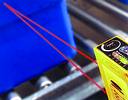

Banner Engineering now produces the Q60 adjustable-field sensors. Designed to eliminate background interference, the new sensors feature a mechanically adjustable sensing cut-off point that allows them to detect objects with relatively low reflectivity while ignoring background objects. A two-turn adjustment screw enables users to set or change the sensing cut-off point from 200 to 2000 mm quickly and easily. A rotating pointer indicates the relative sensing cut-off point by moving clockwise as the cut-off distance increases.
Q60 sensors employ a collimated sensing beam and special lensing to provide high-gain, low-maintenance operation and powerful performance, sensing both dark and light objects reliably at varying ranges. The compact, self-contained sensors provide reliable, and previously unattainable, detection of even the darkest objects at varying distances. Applications include presence sensing within the forest products industry, material handling (including accumulation conveyors and pallet height detection), automotive assembly and process control, feeder bowl level control and any long-range sensing application where other sensing modes are not possible.
The Q60 sensing axis is defined by the location of three optical elements (emitter, near detector and far detector) that line up across the sensor face. The sensors operate by emitting a light beam and comparing the light signals reflected from the sensing target to their (differently aimed) near and far detectors. If the near detector light signal is strongest, the sensor responds to the object. If the far detector light signal is strongest, the sensor ignores the object.
Seven LEDs indicate configuration and operating status during run mode, keeping users constantly aware of sensor performance. During delay configuration, five of the LEDs combine to form a single light bar that indicates the relative on or off delay time.
Two multifunction pushbuttons allow operators to easily set sensor output (on delay and off delay) by selecting one of the 72 increments between 0,008 and 16 s, toggle between light and dark operate mode, or lock out the pushbuttons for security purposes. These functions can also be set using the sensor's remote wire.
The 10-30 V d.c. Q60 sensors have bipolar outputs; one NPN (current sinking) and one PNP (current sourcing); each rated for 150 mA maximum, with a 2 ms response time, and repeatability of 500 ms. Internal circuitry protects against reverse polarity, transient voltage and short-circuit conditions.
The new sensors feature a durable housing moulded from an ABS/polycarbonate blend, with an acrylic lens and a clear ABS cover. They operate in temperatures from -20 to +55°C and meet IP67 environmental ratings. Users can choose models with a 2 or a 9 m attached cable or with a 5-pin rotating Euro-style quick-disconnect fitting which allows the cable to exit from the sensor bottom, back or side.
| Tel: | +27 11 453 2468 |
| Email: | [email protected] |
| www: | www.turckbanner.co.za |
| Articles: | More information and articles about Turck Banner Southern Africa |

© Technews Publishing (Pty) Ltd | All Rights Reserved